Carole Terwilliger Meyers's Blog, page 4
August 24, 2020
Tokyo, Japan: One Night in Tokyo: Shinjuku
ONE NIGHT IN TOKYO: SHINJUKU
The vibrant Shinjuku area of Tokyo is filled with attractions, and though it was cancelled due to the pandemic the 2020 Olympics were scheduled to be here. The area is also a popular choice because it is centered around a busy Bullet Train station. I checked into a hotel for just one night, and I definitely absorbed the energetic flavor of the area and managed to see quite a bit.
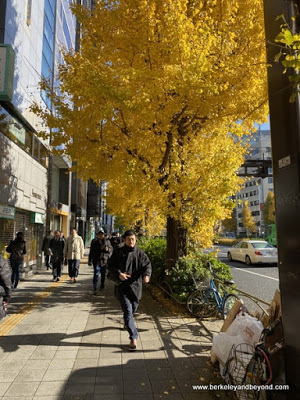 fall color on streets of Tokyo, Japan
fall color on streets of Tokyo, Japancheck in
Shinjuku Washington Hotel 3-2-9, Nishi-shinjuku, 03-3343-3111. Well located, this bustling hotel is just a short walk from the famous Shinjuku section of town. Though it had the smallest room I encountered during my visit to Japan, it manages to include a deep furo soaking tub in each teeny, tiny bathroom . . . and the price is right. I enjoyed meeting the robot valet that hangs out in the lobby in between room service runs, and many small shops operate on the floors below the lobby. During my visit to Japan, I stayed at many sister properties, and all of them provided a white cotton nightgown that buttons down the front--something I started looking forward to each night. And here, a buffet breakfast was served on a high floor permitting lovely area views.
Across the street sits lovely Shinjuku Central Park as well as some of Tokyo’s tallest skyscrapers. The Tokyo Metropolitan Government Office building No.1, which is the tallest city hall in the world, offers free observation decks.
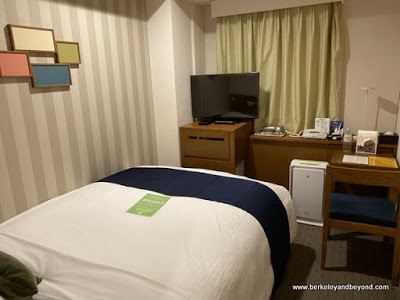 guest room in Shinjuku Washington Hotel in Tokyo, Japan
guest room in Shinjuku Washington Hotel in Tokyo, Japan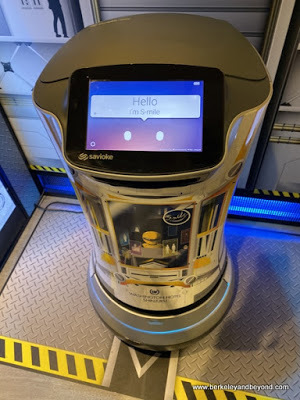 robot valet at Shinjuku Washington Hotel in Tokyo, Japan
robot valet at Shinjuku Washington Hotel in Tokyo, Japan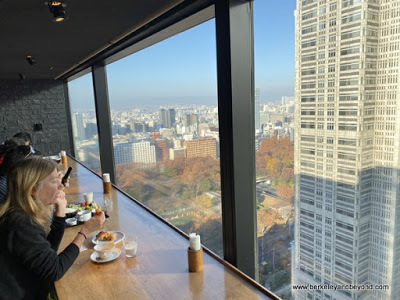 breakfast buffet with a view at Shinjuku Washington Hotel in Tokyo, Japan
breakfast buffet with a view at Shinjuku Washington Hotel in Tokyo, JapanPark Hyatt Tokyo Occupies 39th-52nd floors. Celebrated for being designed by famous architect Kenzo Tange, this skyscraper might be even more famous for its supporting role in the movie Lost in Translation. Even if you don’t stay here, you’ll want to stop in for a drink at the New York Bar on the 52nd floor. Its cool 65-foot-long, four-lane indoor pool--where Bill Murray took a dip in the movie--has floor-to-ceiling windows offering stunning views of Tokyo and Mount Fuji, and a glass pyramid-shaped ceiling allows in natural light.
stroll through Shinjuku
The walk from the hotel to the train station passes an intriguing collection of shops and restaurants. Along the way, the back alley streets are highly interesting. Known as Golden Gai, these narrow streets are lined with small bars with just a few seats. Some are at ground level, while others are positioned up steep staircases, and many are open only to locals. It is on one of these streets that my companion and I found a big bank of vending machines, and the equivalent of US$2 popped out a darling miniature vinyl dog that looked just like her own at home making it the perfect souvenir.
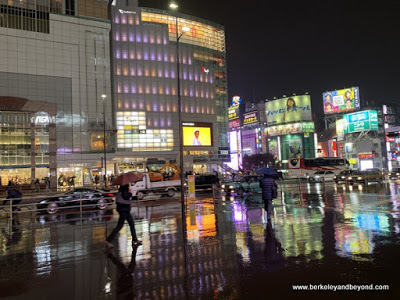 Shinjuku streets in rain in Tokyo, Japan
Shinjuku streets in rain in Tokyo, Japan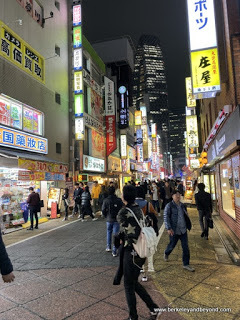 bright lights on Shinjuku streets in Tokyo, Japan
bright lights on Shinjuku streets in Tokyo, Japandinner
Takashimaya Department Store Located in the Times Square area adjacent to the train station, this is considered to be the area’s best department store. Exhibitions and Japanese goods are on floor 11, while a food hall occupies the entire basement and restaurants occupy the top three floors (12-14) referred to as Restaurants Park. After zipping through several of the shopping floors, I headed to the basement and zeroed in on a scrumptious almond croissant from Maison Kayser to take back to my room for dinner. My drink was a bottle of the hotel’s Mt. Fuji spring water.
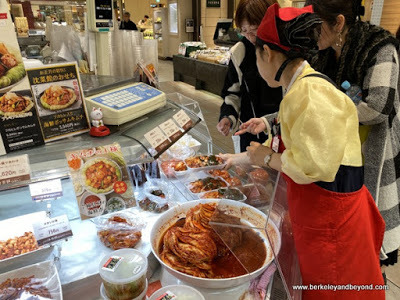 basement food hall at Takashimaya Department Store in Tokyo, Japan
basement food hall at Takashimaya Department Store in Tokyo, Japanif I’d had more time
Shinjuku Gyoen National Garden Near the train station. Tu-Sun 9am-4pm; closed M. 500 yen. Stretched over 144 acres, this former imperial garden became a national garden after World War II. The park holds native and traditional gardens as well as French Formal and English Landscape gardens, plus a spectacular Taiwan Pavilion that perches beside a serene pond.
Yayoi Kusama Museum Thur-M. 1,100 yen. Located off the beaten path in a suburban district of Shinjuku, this slim 5-story white building is devoted to displaying the larger-than-life and avant-garde works of artist Yayoi Kusama. Installations include her newish "infinity room" series (an Instagram sensation), polka-dot paintings, and sculptures. Note that visitors are limited to only 200 per day.
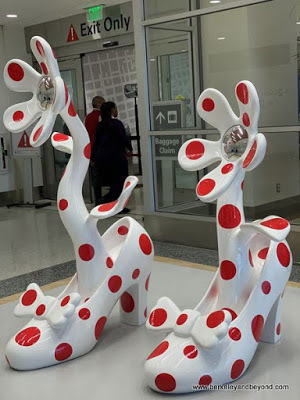 polka dot shoes by Yayoi Kusama, displayed at SFO airport in San Francisco, California
polka dot shoes by Yayoi Kusama, displayed at SFO airport in San Francisco, Californiacat cafes
In Japan living space is at a premium and most landlords do not permit pets, so cat cafes are a popular and ingenious solution. Patrons pay an hourly fee (usually about US$10 per hour) for a cup of coffee or tea to enjoy amid free-roaming cats.
Located in the center of Shinjuku, the Calico Cat Cafe opened in 2007 and has about 20 cats representing 17 breeds. Rules include not waking a sleeping cat and not bringing catnip in to the cafe.
Note that the first cat cafe in the U.S. opened in Oakland, California in 2014.
Like most U.S. cat cafes, Cat Town adopts out the cats.
More things to do in Japan.
Great ideas for travel adventures in California and the U.S. and around the world.
images and video ©2020 Carole Terwilliger Meyers
Published on August 24, 2020 14:39
August 3, 2020
Sendai, Japan: Nikka Whisky Miyagikyo Distillery Tour; things to do
Nikka Whisky Miyagikyo Distillery Tour +81 0 22-395-2865. Daily 9am-4:30pm. Free. Reservations suggested.
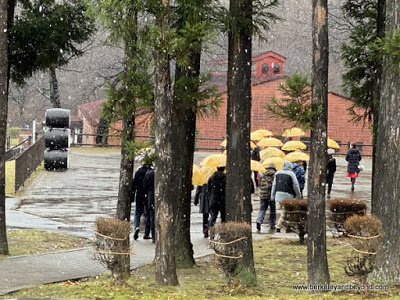
Built in 1969, this is Nikka Whisky’s second distillery. Masataka Taketsuru, who learned whisky-making in Scotland, started the company and makes what has been called the father of whiskey--Nikka Whisky. The distillery is located in a foggy glen surrounded by mountains and is adjacent to two rivers, including its famous source of pristine water, the Nikkawa River. Both malt and grain whisky are produced here. An educational tour of the refinery includes strolling the lovely grounds and viewing a scenic pond with swans. As an overview of production is presented, tour groups enter several buildings, including the kiln tower, mash house, and still house.
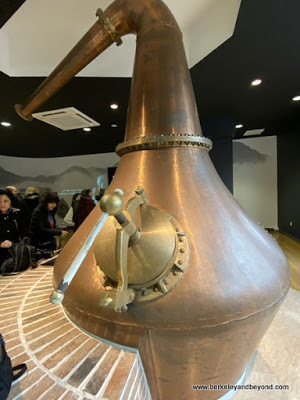
The hour-long tour concludes with a tasting, where whisky descriptions vary from “fruity and rich” for the Single malt Miyagikyo to “woody and mellow” for the Coffey Grain. I liked them all. The tour is conducted in Japanese, but audio guides in English, Chinese, and Korean are available.
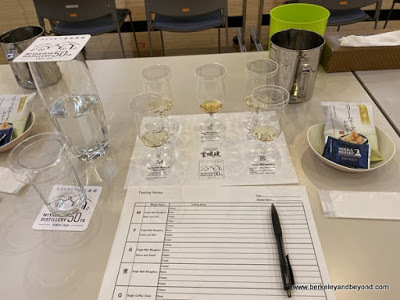
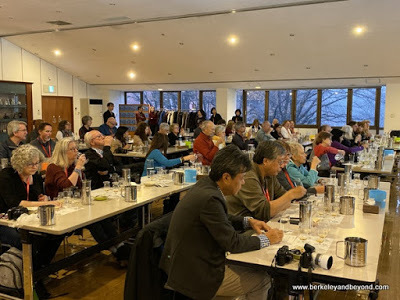
More things to do in Japan.
Great ideas for travel adventures in California and the U.S. and around the world.
images and video ©2020 Carole Terwilliger Meyers
Published on August 03, 2020 13:44
July 21, 2020
Morioka, Japan: Azumaya Soba Shop; restaurant review
Azumaya Soba Shop Nakanohashi Ave. 1-8-3 (several more locations are in Morioka), 0120-733-130.
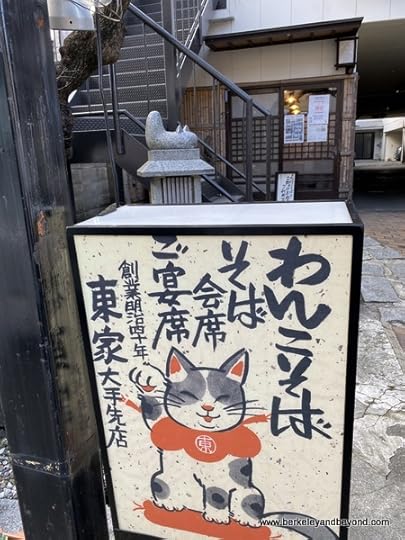 entrance to Azumaya Soba Shop in Morioka, Japan
entrance to Azumaya Soba Shop in Morioka, JapanThis all-you-can-eat cold soba noodle experience involves wearing a special apron, sitting on the floor on a tatami mat at a low table, and then eating small portions of noodles served in lacquered wooden bowls that are stacked up as they are emptied. Guests are allowed to dump the liquid soup in a special bowl so that they have more space in their tummies for noodles, and are encouraged by chanting servers to eat more and more--as much as they can. Near the end, fellow diners sometimes join in the chant. Service does not stop until the diner puts the lid on their final bowl, meaning they have had enough.
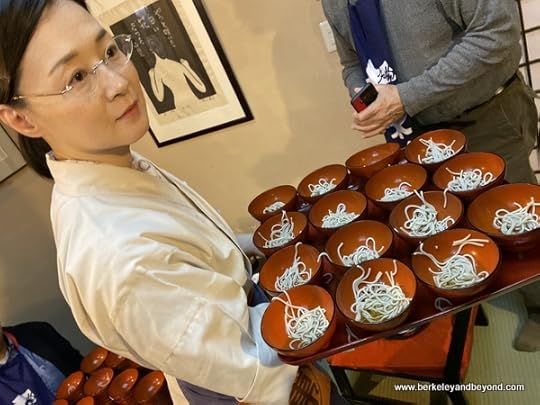 noodle servings at Azumaya Soba Shop in Morioka, Japan
noodle servings at Azumaya Soba Shop in Morioka, Japan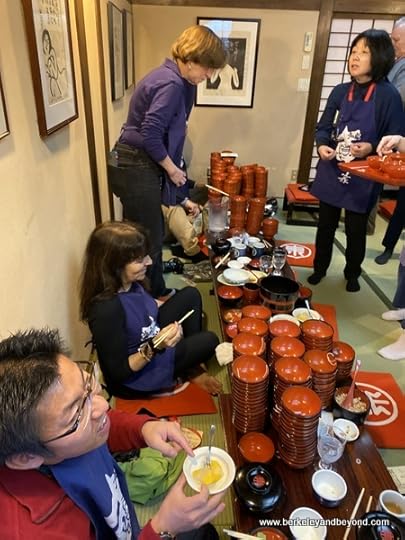 diners at Azumaya Soba Shop in Morioka, Japan
diners at Azumaya Soba Shop in Morioka, JapanThis is not just dinner, it is a contest called wanko soba. The record here is 500 bowls of noodles eaten by a man from Osaka, and 570 bowls eaten by a local Morioka woman. Each bowl holds only a few noodles, and 15 bowls--which is equivalent to an ordinary full bowl of soba--is average. The Noodle King in my group downed 100 bowls!, while I managed only 19. Part of the fun is that the empty bowls are stacked up beside each diner, and as the meal winds down people try to eat more and more. A few spices and toppings are provided for taste, and soba soup or tea is served when the contest is over. Once popular all over Japan after World War II, this eating sport remains particularly popular in this area. A few other area noodle houses also provide the same fun.
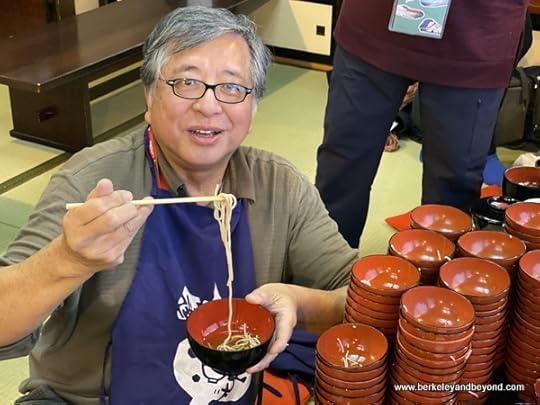 American Noodle King David Lang at Azumaya Soba Shop in Morioka, Japan
American Noodle King David Lang at Azumaya Soba Shop in Morioka, Japan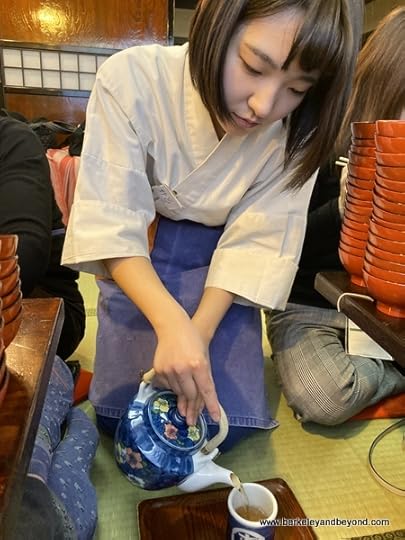 tea service at Azumaya Soba Shop in Morioka, Japan
tea service at Azumaya Soba Shop in Morioka, JapanMore things to do in Japan.
Great ideas for travel adventures in California and the U.S. and around the world.
images ©2020 Carole Terwilliger Meyers
Published on July 21, 2020 12:56
July 16, 2020
England's Other Potter: Beatrix Potter sites in the Lake District
England's Other Potter Beatrix Potter sites in the Lake District
Her real name is Helen Beatrix Potter. Notice that it starts with the same initial as Harry. And like J. K. Rowling, the author of the other Potter stories, Beatrix Potter, the author of the bunny tales, became wealthy from her writing. Hmmmm. Similarities end there. Read more . . .
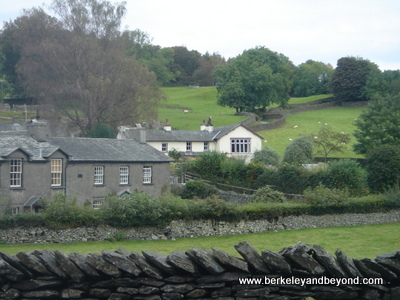
Some travel articles to inspire and help you plan spectacular getaways.
article and image c2020 Carole Terwilliger Meyers
Published on July 16, 2020 12:38
July 10, 2020
Hachimantai city, Japan: Hachimantai Geothermal Dyeing at Geocolor; things to do
Geocolor: Hachimantai Geothermal Dyeing In Hachimantai city, Matsuoyoriki, 0195-78-2451.
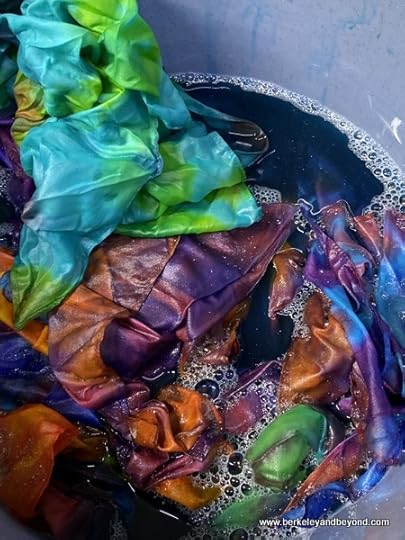 tie-died cloths in rinse bucket at Geocolor: Hachimantai Geothermal Dyeing
tie-died cloths in rinse bucket at Geocolor: Hachimantai Geothermal Dyeingin Hachimantai city, Japan
At this oldest geothermal area in Japan, which dates back almost 50 years to 1966 and is located in an area famous for skiing, visitors can watch as professionals dye fabric with geothermal steam that uses energy from hot springs and contains a perfect balance of hydrogen sulfide. This is the only place in the world where public thermal dying is done. It is an eco-friendly process, and it creates the perfect gradation of colors. At this facility, visitors can try their hand at dyeing handkerchiefs or small scarves. The process involves tying fabric squares into cigar-like shapes, then dipping them in color, steaming them in a geothermal oven, and finally unwrapping them to the delight of all.
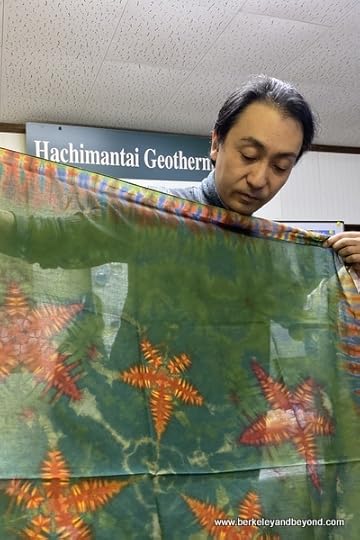 instructor holds sample tie-died cloth with starfish design at
instructor holds sample tie-died cloth with starfish design at Geocolor: Hachimantai Geothermal Dyeing in Hachimantai city, Japan
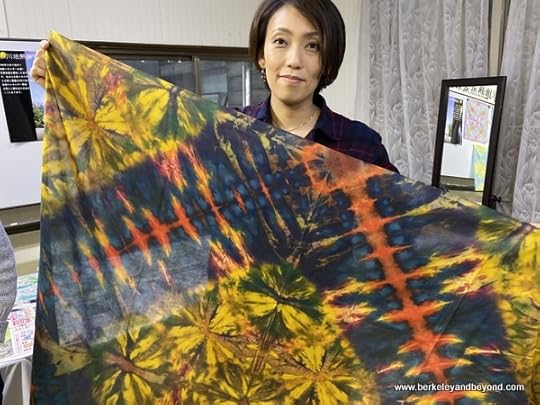 instructor holds sample tie-died cloth at
instructor holds sample tie-died cloth at Geocolor: Hachimantai Geothermal Dyeing in Hachimantai city, Japan
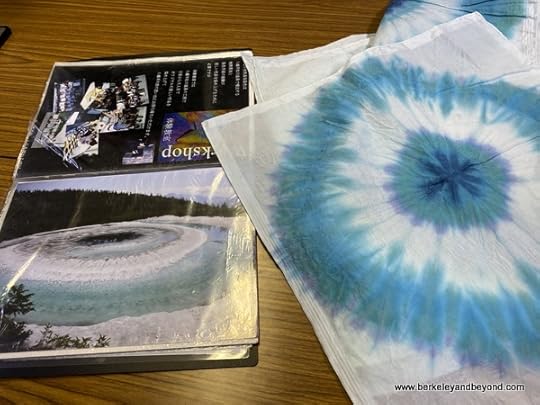 tie-died cloth based on photo in book at
tie-died cloth based on photo in book at Geocolor: Hachimantai Geothermal Dyeing in Hachimantai city, Japan
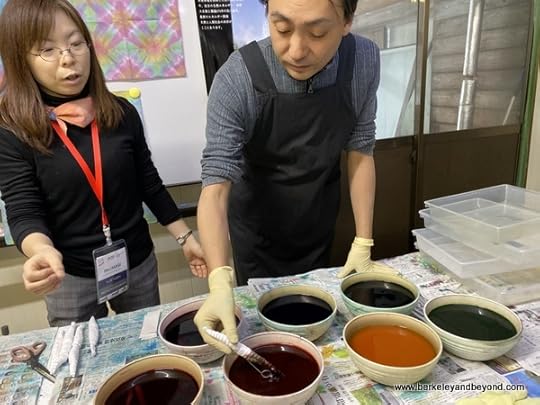 instructor demonstrates dipping tie-died cloth at
instructor demonstrates dipping tie-died cloth at Geocolor: Hachimantai Geothermal Dyeing in Hachimantai city, Japan
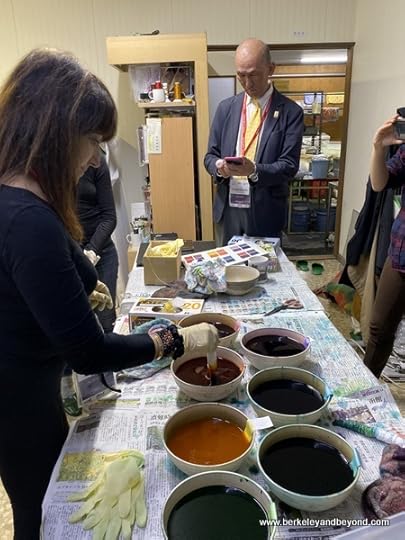 student dips tie-died cloth at
student dips tie-died cloth at Geocolor: Hachimantai Geothermal Dyeing in Hachimantai city, Japan
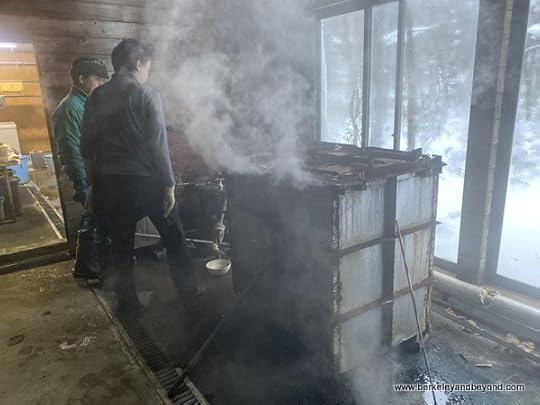 thermal steam oven at
thermal steam oven at Geocolor: Hachimantai Geothermal Dyeing in Hachimantai city, Japan
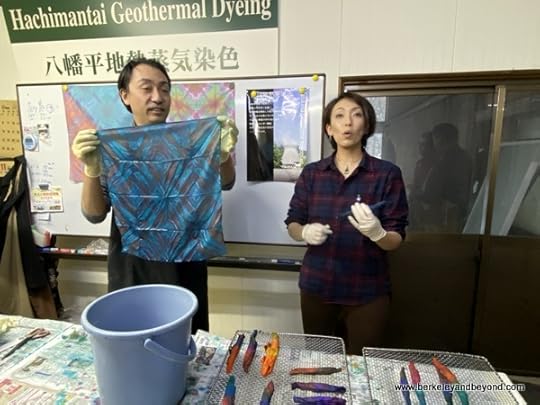 instructor displays student's tie-dyed cloth at
instructor displays student's tie-dyed cloth at Geocolor: Hachimantai Geothermal Dyeing in Hachimantai city, Japan
After, participants enjoy coffee or tea in the cozy AlpenRose cafe and gift shop, where the instructor irons each scarf to lock in the color and where lovely tie-dyed pieces are displayed, some of which are for sale.
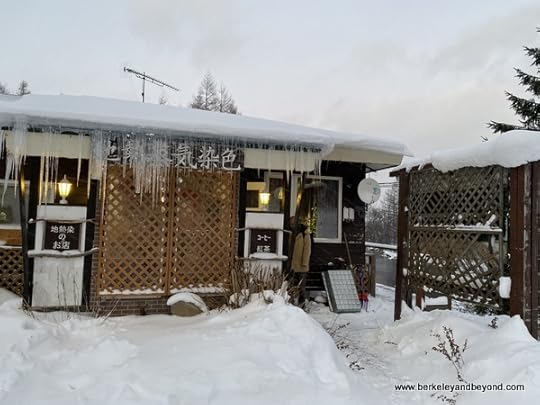 exterior of AlpenRose cafe at
exterior of AlpenRose cafe at Geocolor: Hachimantai Geothermal Dyeing in Hachimantai city, Japan
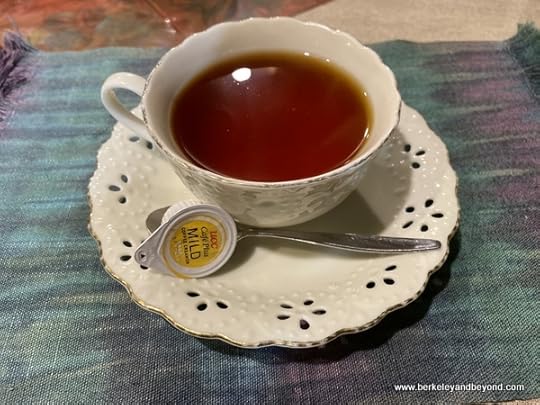 cup of tea at AlpenRose cafe at
cup of tea at AlpenRose cafe at Geocolor: Hachimantai Geothermal Dyeing in Hachimantai city, Japan
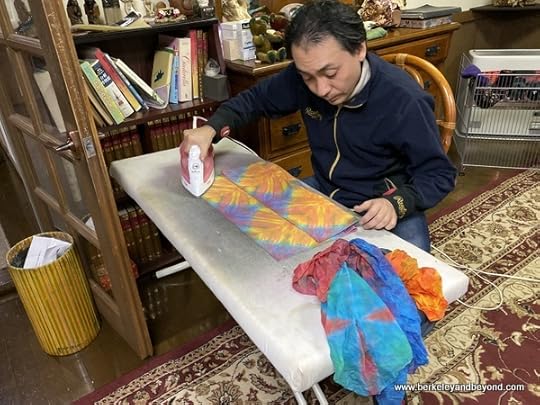 instructor irons student projects at AlpenRose cafe at
instructor irons student projects at AlpenRose cafe at Geocolor: Hachimantai Geothermal Dyeing in Hachimantai city, Japan
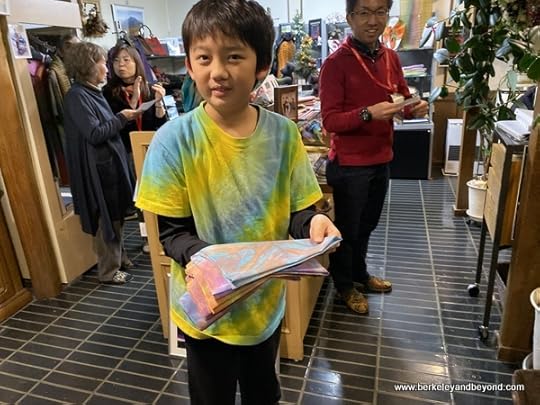 young boy delivers finished student projects at AlpenRose cafe at
young boy delivers finished student projects at AlpenRose cafe at Geocolor: Hachimantai Geothermal Dyeing in Hachimantai city, Japan
More things to do in Japan.
Great ideas for travel adventures in California and the U.S. and around the world.
images ©2020 Carole Terwilliger Meyers
Published on July 10, 2020 10:07
Hachimantai city Japan: Hachimantai Geothermal Dyeing at Geocolor; things to do
Geocolor: Hachimantai Geothermal Dyeing In Hachimantai city, Matsuoyoriki, 0195-78-2451.
 tie-died cloths in rinse bucket at Geocolor: Hachimantai Geothermal Dyeing
tie-died cloths in rinse bucket at Geocolor: Hachimantai Geothermal Dyeingin Hachimantai city, Japan
At this oldest geothermal area in Japan, which dates back almost 50 years to 1966 and is located in an area famous for skiing, visitors can watch as professionals dye fabric with geothermal steam that uses energy from hot springs and contains a perfect balance of hydrogen sulfide. This is the only place in the world where public thermal dying is done. It is an eco-friendly process, and it creates the perfect gradation of colors. At this facility, visitors can try their hand at dyeing handkerchiefs or small scarves. The process involves tying fabric squares into cigar-like shapes, then dipping them in color, steaming them in a geothermal oven, and finally unwrapping them to the delight of all.
 instructor holds sample tie-died cloth with starfish design at
instructor holds sample tie-died cloth with starfish design at Geocolor: Hachimantai Geothermal Dyeing in Hachimantai city, Japan
 instructor holds sample tie-died cloth at
instructor holds sample tie-died cloth at Geocolor: Hachimantai Geothermal Dyeing in Hachimantai city, Japan
 tie-died cloth based on photo in book at
tie-died cloth based on photo in book at Geocolor: Hachimantai Geothermal Dyeing in Hachimantai city, Japan
 instructor demonstrates dipping tie-died cloth at
instructor demonstrates dipping tie-died cloth at Geocolor: Hachimantai Geothermal Dyeing in Hachimantai city, Japan
 student dips tie-died cloth at
student dips tie-died cloth at Geocolor: Hachimantai Geothermal Dyeing in Hachimantai city, Japan
 thermal steam oven at
thermal steam oven at Geocolor: Hachimantai Geothermal Dyeing in Hachimantai city, Japan
 instructor displays student's tie-dyed cloth at
instructor displays student's tie-dyed cloth at Geocolor: Hachimantai Geothermal Dyeing in Hachimantai city, Japan
After, participants enjoy coffee or tea in the cozy AlpenRose cafe and gift shop, where the instructor irons each scarf to lock in the color and where lovely tie-dyed pieces are displayed, some of which are for sale.
 exterior of AlpenRose cafe at
exterior of AlpenRose cafe at Geocolor: Hachimantai Geothermal Dyeing in Hachimantai city, Japan
 cup of tea at AlpenRose cafe at
cup of tea at AlpenRose cafe at Geocolor: Hachimantai Geothermal Dyeing in Hachimantai city, Japan
 instructor irons student projects at AlpenRose cafe at
instructor irons student projects at AlpenRose cafe at Geocolor: Hachimantai Geothermal Dyeing in Hachimantai city, Japan
 young boy delivers finished student projects at AlpenRose cafe at
young boy delivers finished student projects at AlpenRose cafe at Geocolor: Hachimantai Geothermal Dyeing in Hachimantai city, Japan
More things to do in Japan.
Great ideas for travel adventures in California and the U.S. and around the world.
images ©2020 Carole Terwilliger Meyers
Published on July 10, 2020 10:07
June 18, 2020
Aomori city, Japan: Oirase National Park; things to do
Enjoy pizza, do some forest bathing, and overnight at an onsen
Oirase National Park This has been a national park for 80 years and is a protected nature zone. It is particularly beautiful in winter.
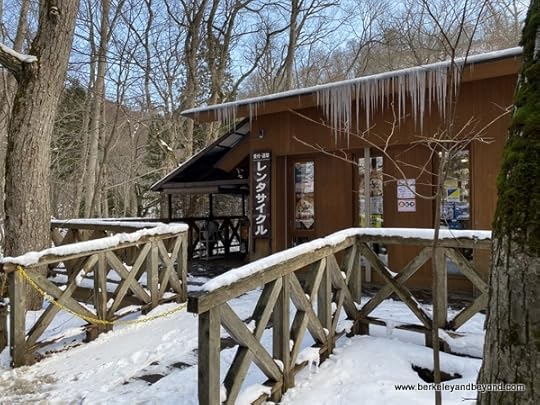 visitor center in Oirase National Park in Aomori, Japan
visitor center in Oirase National Park in Aomori, JapanOirase Gorge, Lake Towada, and Tsuta no Mori offer giant ancient trees, moss banked streams and mountains along with blissful silence. This gorge has three sections--the white-branched beech trees, the moss-covered rocks, and the waterfalls.
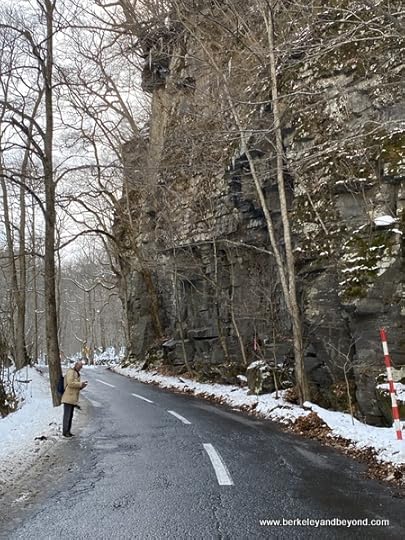 road through Oirase Gorge in Oirase National Park in Aomori, Japan
road through Oirase Gorge in Oirase National Park in Aomori, JapanOirase Walk A beautiful walking trail leads up an easy incline from the visitor center to Lake Towada. The trail follows the clear Oirase Keiryu stream and passes the ancient Choshi Otaki waterfall. In winter, when walking in slippery snow can be treacherous, my group was taken by bus along the main road through the park and let out at various sights along the way. Any time, a nature guide enhances the experience.
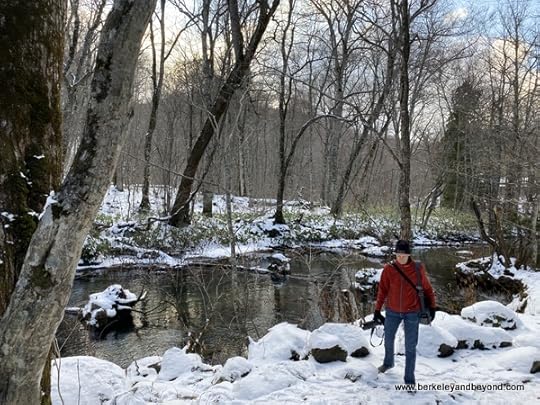 river through Oirase Gorge in Oirase National Park in Aomori, Japan
river through Oirase Gorge in Oirase National Park in Aomori, Japan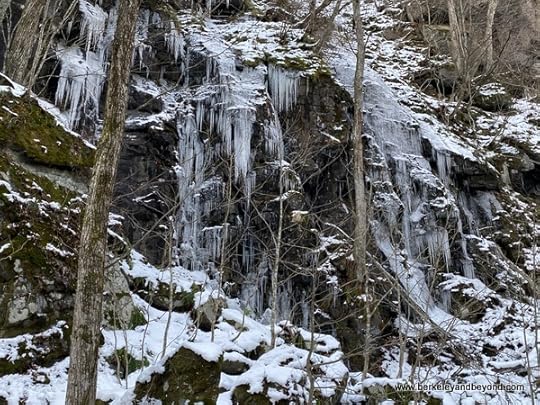 frozen waterfall in Oirase Gorge in Oirase National Park in Aomori, Japan
frozen waterfall in Oirase Gorge in Oirase National Park in Aomori, Japan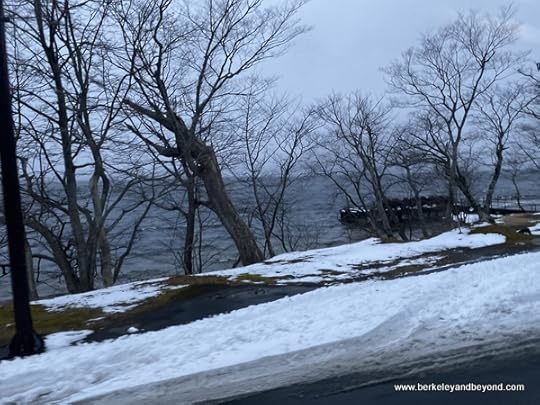 Lake Towada in Oirase National Park in Aomori, Japan
Lake Towada in Oirase National Park in Aomori, JapanOirase Frozen Waterfall Walk On this evening walk, participants witness the unique, ever-changing frozen waterfalls of Oirase, which are illuminated amid the snowy scenery.
Oirase Bath with Ice Cascade Another special experience allows soaking in open-air baths while gazing below upon streams and massive frozen waterfalls.
Not too far away but still seemingly out in the boonies, it is quite a surprise to find Ortolana set within a Scandinavian-style building and serving a first-rate pizza with cracker-thin crust. Pizzas are cooked in a rustic stone oven and come in several varieties, including vegetarian, as well as apple or other seasonal fruits (for dessert). The spectacular roasted potatoes are a don't miss.
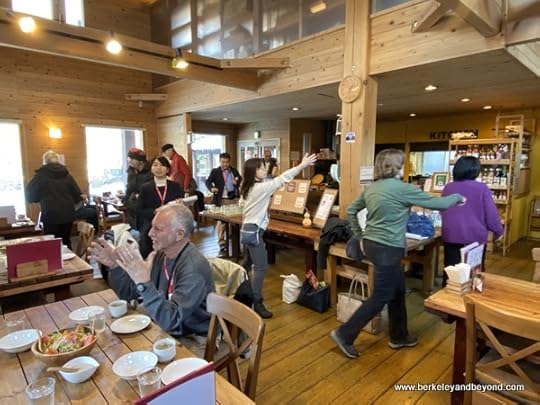 interior of Ortolana pizza cafe in Aomori, Japan
interior of Ortolana pizza cafe in Aomori, Japan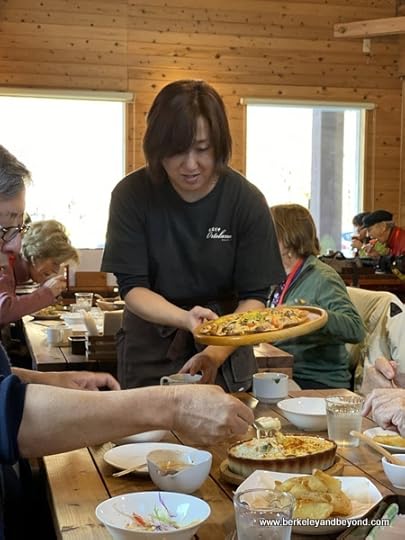 server fills table at Ortolana pizza cafe in Aomori, Japan
server fills table at Ortolana pizza cafe in Aomori, Japan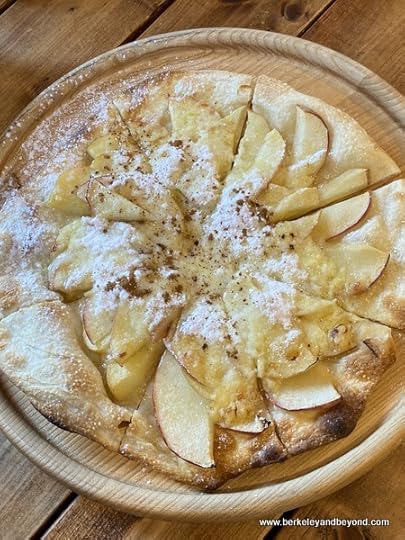 apple pizza dessert at Ortolana pizza cafe in Aomori, Japan
apple pizza dessert at Ortolana pizza cafe in Aomori, Japan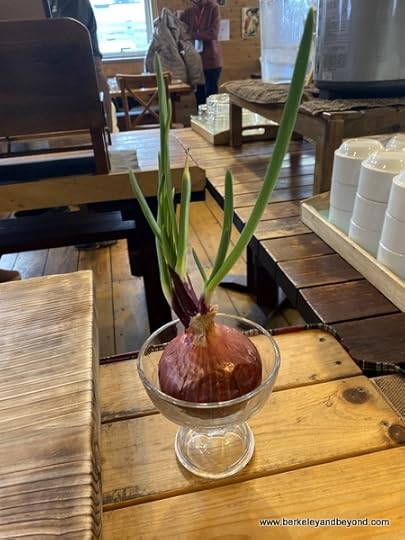 sprouted red onion at Ortolana pizza cafe in Aomori, Japan
sprouted red onion at Ortolana pizza cafe in Aomori, JapanWithin range for overnighting, the hilltop European-style mountain resort onsen Hotel Jogakura is surrounded by virgin beech forests. This scenically-situated onsen features a hot spring with both a sleek modern indoor bath and a rustic rock-lined outdoor bath. It has 31 room and presents beautifully served traditional farm-and-sea-to-table Japanese cuisine--the chef himself selects locally-caught ocean fish daily at the market. My delightful dinner here was punctuated with the excitement of seeing a furry golden Japanese marten hunting in the snow for its own dinner outside the dining room window.
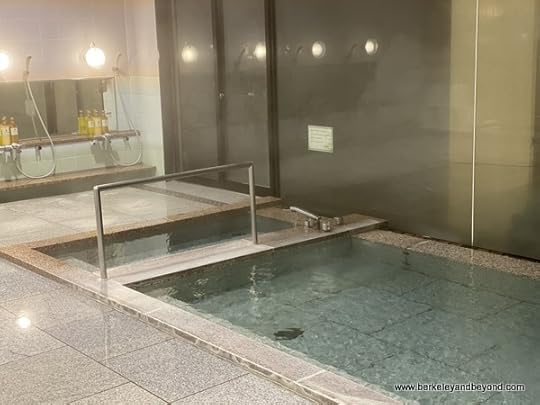 onsen bath at Hotel Jogakura in Amori, Japan
onsen bath at Hotel Jogakura in Amori, Japan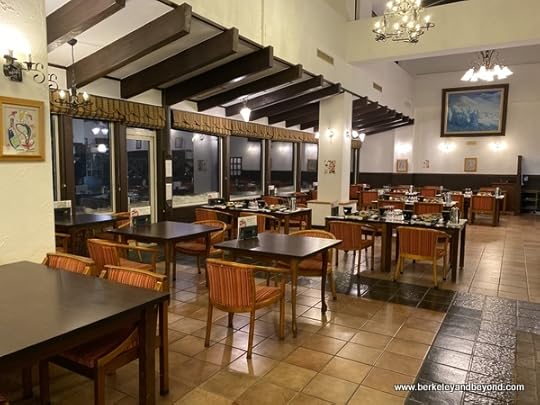 dining room at Hotel Jogakura in Amori, Japan
dining room at Hotel Jogakura in Amori, Japan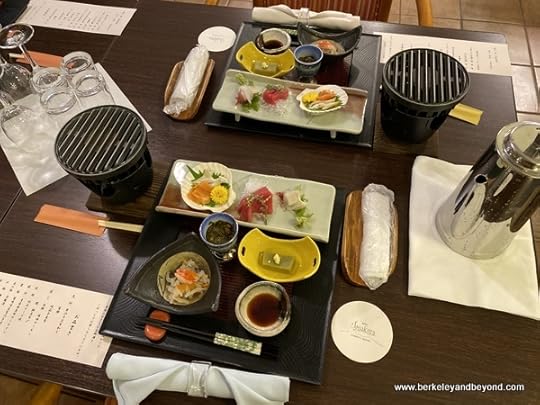 table setting at Hotel Jogakura in Amori, Japan
table setting at Hotel Jogakura in Amori, Japan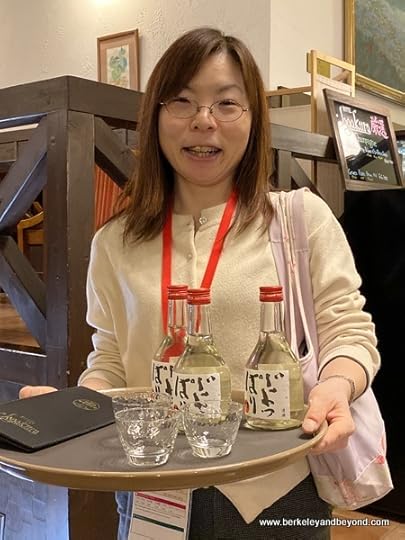 sake service at Hotel Jogakura in Amori, Japan
sake service at Hotel Jogakura in Amori, Japan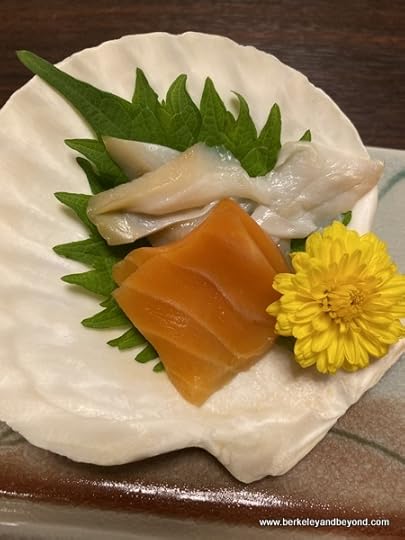 appetizer at Hotel Jogakura in Amori, Japan
appetizer at Hotel Jogakura in Amori, Japan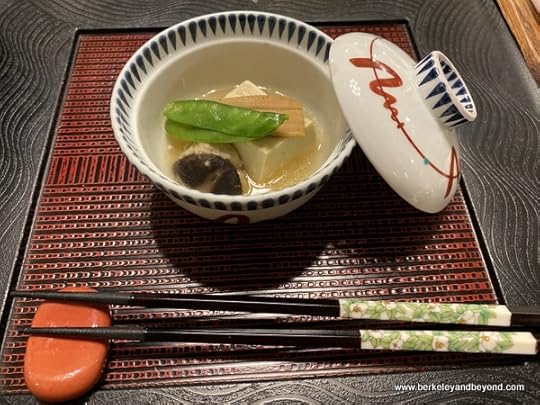 soup at Hotel Jogakura in Amori, Japan
soup at Hotel Jogakura in Amori, Japan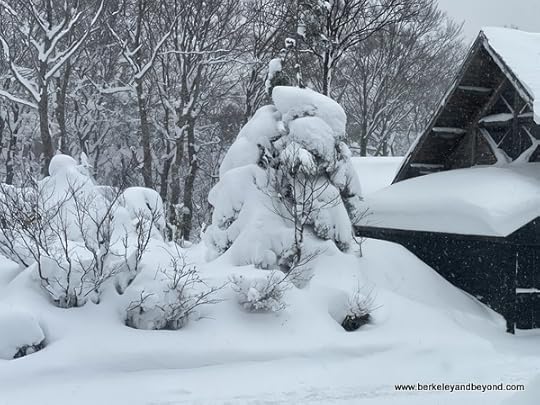 snow monster outside Hotel Jogakura in Amori, Japan
snow monster outside Hotel Jogakura in Amori, JapanMore things to do in Japan.
Great ideas for travel adventures in California and the U.S. and around the world.
images ©2020 Carole Terwilliger Meyers
Published on June 18, 2020 14:46
June 9, 2020
Nagano, Japan: Yudanka Onsen Yoroduya; hotel review
Yudanka Onsen Yoroduya 3137 Heiin, Yamanouchi-cho, Shimo-takai-gun, Nagano. Restaurant.
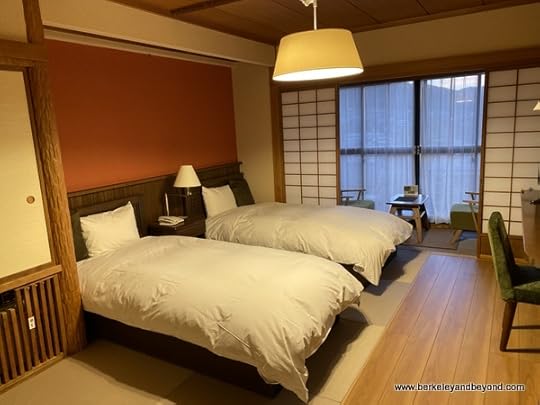 western tatami room at Yudanka Onsen Yoroduya ryokan in Nagano, Japan
western tatami room at Yudanka Onsen Yoroduya ryokan in Nagano, JapanThis large-yet-cozy traditional ryokan inn has an authentic Japanese atmosphere and onsen hot baths. Traditional tatami rooms are the rule, but a western variation is available. My room was essentially a tatami room with raised beds--it had tatami flooring, sliding doors, and an enclosed deck where I could look out over the town and surrounding mountains. Guests here are asked to keep the deck doors closed because wild monkeys roam the area. A large bathhouse is constructed from the sacred tree of Mt. Koya--Japanese Umbrella Pine--and has morning hours for men and evening hours for women. Baths include a Momoyama Bath and an open-air bath, as well as private baths at an additional fee. Waters are effective for wounds, burns, pruritus cutaneous, rheumatic diseases, movement disorders, chronic eczema, female disorders, postmenopausal syndrome, and neuralgia. The night I stayed here I was simply too tired and used the pink deep tub in my room instead, which also pumped in the hot mineral water. I noticed that the next day I perspired heavily and deduced that was the mineral salts at work.
Onsen etiquette requires quiet talking. Bathers are usually required to be nude, and tattoos are usually not permitted. More helpful information.
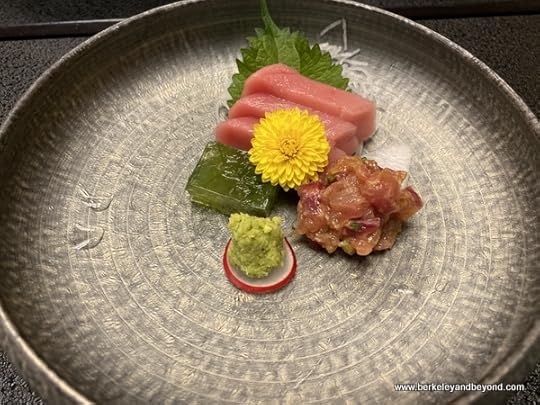 appetizer plate at Yudanka Onsen Yoroduya ryokan in Nagano, Japan
appetizer plate at Yudanka Onsen Yoroduya ryokan in Nagano, Japan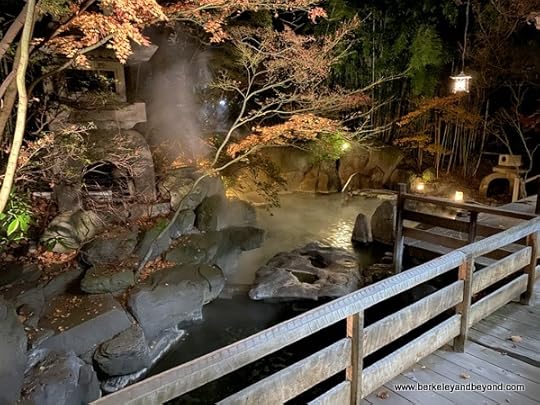 outdoor onsen at Yudanka Onsen Yoroduya ryokan in Nagano, Japan
outdoor onsen at Yudanka Onsen Yoroduya ryokan in Nagano, Japan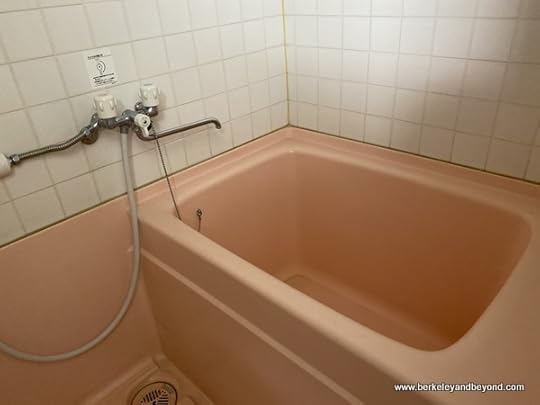 in-room deep tub at Yudanka Onsen Yoroduya ryokan in Nagano, Japan
in-room deep tub at Yudanka Onsen Yoroduya ryokan in Nagano, Japan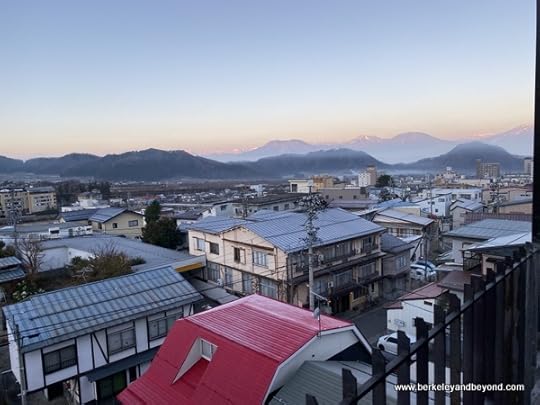 sunrise from room balcony at Yudanka Onsen Yoroduya ryokan in Nagano, Japan
sunrise from room balcony at Yudanka Onsen Yoroduya ryokan in Nagano, JapanMore things to do in Japan.
Great ideas for travel adventures in California and the U.S. and around the world.
images ©2020 Carole Terwilliger Meyers
Published on June 09, 2020 13:58
June 3, 2020
Iiyama city (Nagano), Japan: Iiyama Handicraft Paper Studio + Iiyama Museum of Traditional Folk Industry + Iiyama City Museum + Soba restaurant Kowana; things to do + restaurant review
Paper making, crafts displays, and tasting soba noodles in Iiyama city, Japan
Iiyama Handicraft Paper Studio Iiyama city. Tu-Sun 9am-5pm. Make 1 postcard/210 yen.
 sign for Iiyama Handicraft Paper Studio in Iiyama city, Japan
sign for Iiyama Handicraft Paper Studio in Iiyama city, JapanInstructor Masumi Hirata came here 12 years ago. Learn from her how delicate traditional papers have been fashioned for almost four centuries. Because of the heavy snowfall in this area, people couldn’t farm in winter. They started making paper from the Japanese mulberry tree, using the bark that they they bleached white with snow. This craft is dying out as the craftsmen die, and no one replaces them. Nowadays fine paper is made only in small studios like this, and this special class provides the opportunity to make your own sample post card.
[image error] instructor Masumi Hirata at Iiyama Handicraft Paper Studio in Iiyama city, Japan
 mulberry bark drying outside Iiyama Handicraft Paper Studio in Iiyama city, Japan
mulberry bark drying outside Iiyama Handicraft Paper Studio in Iiyama city, Japan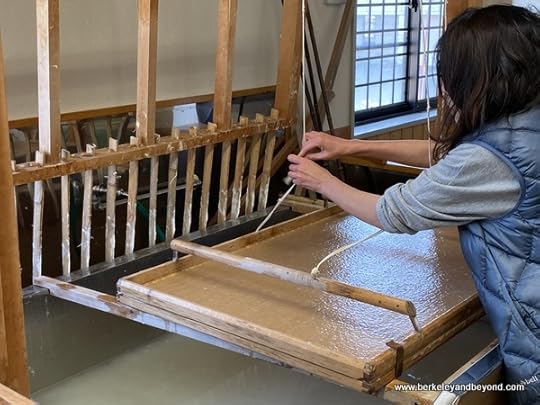 instructor Masumi Hirata demonstrates paper-making at Iiyama Handicraft Paper Studio
instructor Masumi Hirata demonstrates paper-making at Iiyama Handicraft Paper Studio in Iiyama city, Japan
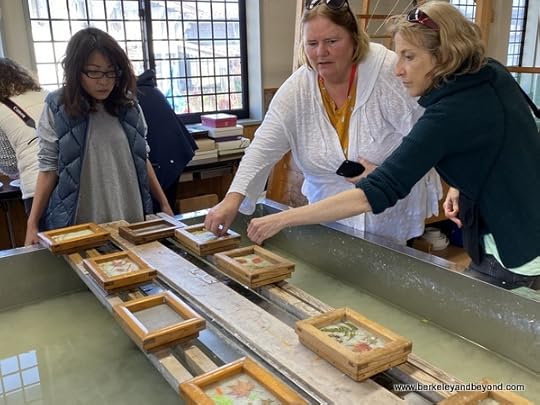 students decorate cards in paper-making at Iiyama Handicraft Paper Studio
students decorate cards in paper-making at Iiyama Handicraft Paper Studio in Iiyama city, Japan
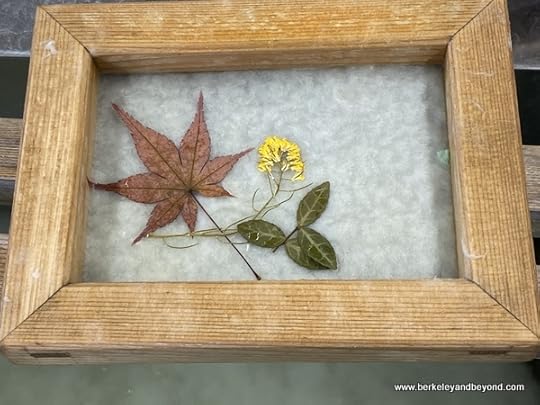 sample card in paper-making at Iiyama Handicraft Paper Studio in Iiyama city, Japan
sample card in paper-making at Iiyama Handicraft Paper Studio in Iiyama city, JapanIiyama Museum of Traditional Folk Industry + Iiyama City Museum 1436-1, Iiyama city, 389-2253. Tu-Sun, 9am-5pm. 300 yen.
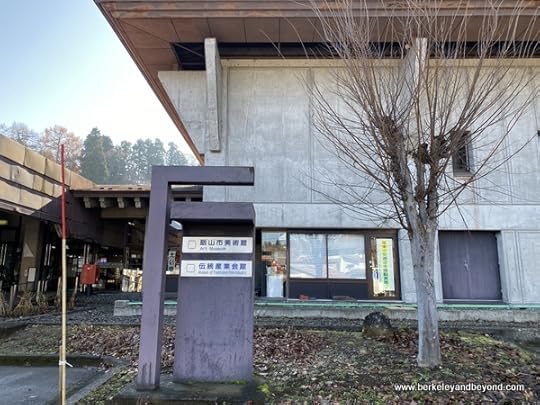 exterior of Iiyama Museum of Traditional Folk Industry in Iiyama city, Japan
exterior of Iiyama Museum of Traditional Folk Industry in Iiyama city, JapanJust next door, this museum appropriately displays a collection handmade Japanese paper as well as Buddhist altars and displays of traditional crafts of the Nagano prefecture--lacquer ware, wood furniture, silk thread, hand-forged cutting blades, and wood-turning.
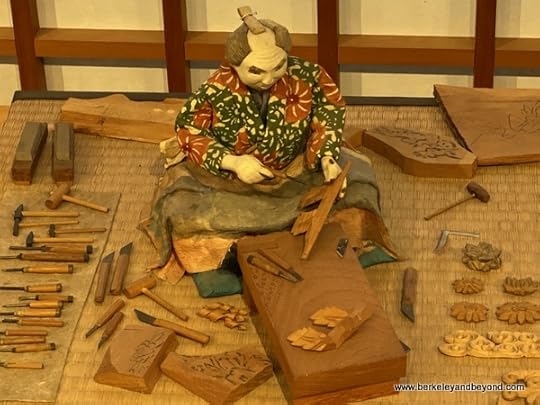 woodworker figure at Iiyama Museum of Traditional Folk Industry in Iiyama city, Japan
woodworker figure at Iiyama Museum of Traditional Folk Industry in Iiyama city, Japan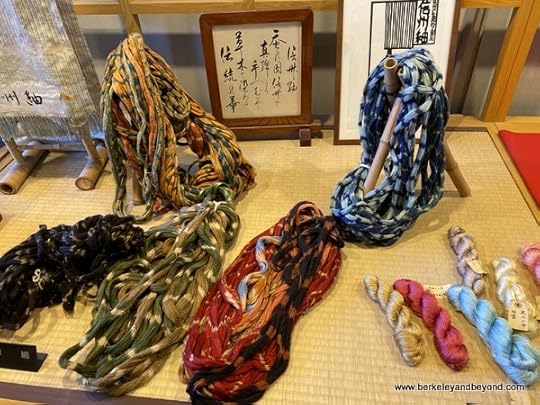 dyed silk thread at Iiyama Museum of Traditional Folk Industry in Iiyama city, Japan
dyed silk thread at Iiyama Museum of Traditional Folk Industry in Iiyama city, Japan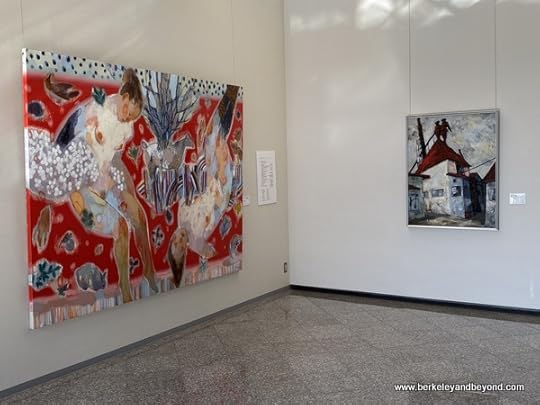 contemporary art at Iiyama Museum of Traditional Folk Industry in Iiyama city, Japan
contemporary art at Iiyama Museum of Traditional Folk Industry in Iiyama city, Japan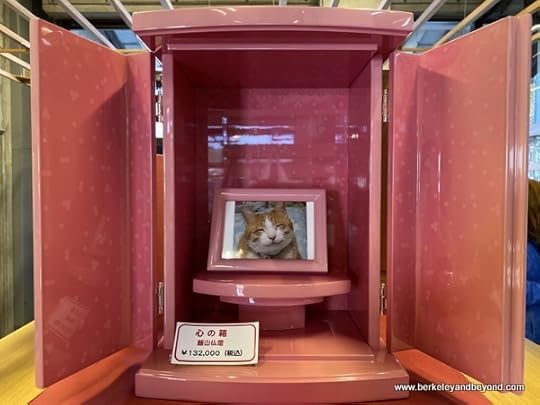 laquer-ware pink cat altar in gift shop at Iiyama Museum of Traditional Folk Industry
laquer-ware pink cat altar in gift shop at Iiyama Museum of Traditional Folk Industry in Iiyama city, Japan
Soba restaurant Kowana (also referred to as Soba-dokoro Korin) 1200 Iiyama Burari-hiroba, Iiyama, +81 269-63-2978.
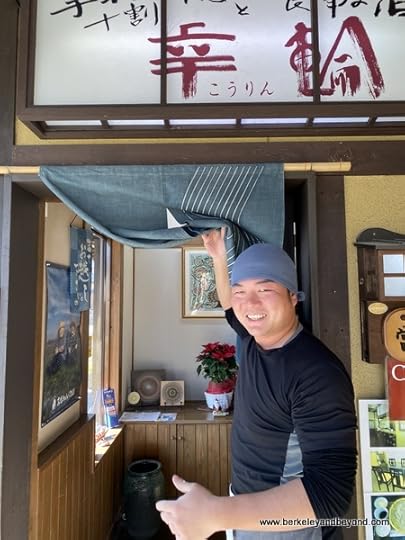 welcome to Soba restaurant Kowana in Iiyama city, Japan
welcome to Soba restaurant Kowana in Iiyama city, JapanMy lunch at this nearby family-run spot was a tasting of finely crafted buckwheat soba noodles served in a variety of fragrant broths. Buckwheat flour used for the noodles is cultivated organically and mixed with natural water from Kijima Hirauchiyama. Diners are encouraged to sprinkle a little bit of salt on a bite of soba before eating it with the spicy soup. Yakumi (green onions and wasabi) are provided only by request, so that you can enjoy the original sweet flavor of soba. As we left, our guide exclaimed, “It was the best soba noodle I ever had!”
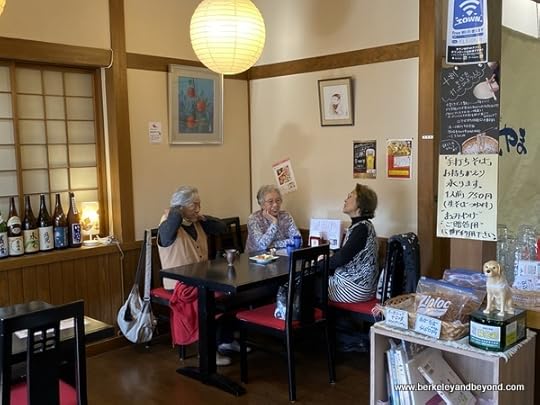 interior of Soba restaurant Kowana in Iiyama city, Japan
interior of Soba restaurant Kowana in Iiyama city, Japan[image error] artistic appetizer plate at Soba restaurant Kowana in Iiyama city, Japan
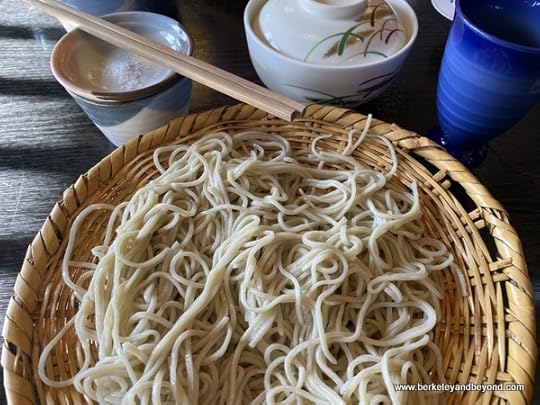 soba noodles plate at Soba restaurant Kowana in Iiyama city, Japan
soba noodles plate at Soba restaurant Kowana in Iiyama city, Japan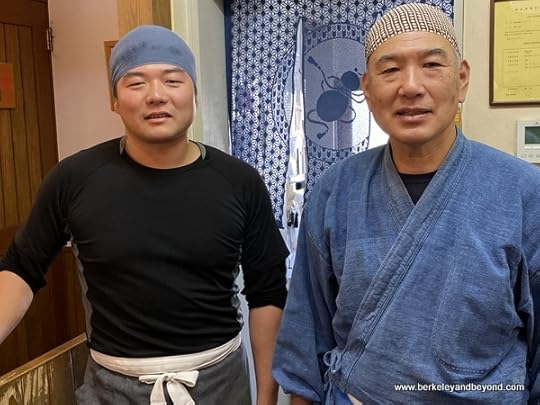 father and son chef team at Soba restaurant Kowana in Iiyama city, Japan
father and son chef team at Soba restaurant Kowana in Iiyama city, JapanAll about soba.
More things to do in Japan.
Great ideas for travel adventures in California and the U.S. and around the world.
images ©2020 Carole Terwilliger Meyers
Published on June 03, 2020 14:04
Iiyama city (Nagano), Iiyama Handicraft Paper Studio + Iiyama Museum of Traditional Folk Industry + Iiyama City Museum + Soba restaurant Kowana; things to do + restaurant review
Paper making, crafts displays, and tasting soba noodles in Iiyama city, Japan
Iiyama Handicraft Paper Studio Iiyama city. Tu-Sun 9am-5pm. Make 1 postcard/210 yen.
 sign for Iiyama Handicraft Paper Studio in Iiyama city, Japan
sign for Iiyama Handicraft Paper Studio in Iiyama city, JapanInstructor Masumi Hirata came here 12 years ago. Learn from her how delicate traditional papers have been fashioned for almost four centuries. Because of the heavy snowfall in this area, people couldn’t farm in winter. They started making paper from the Japanese mulberry tree, using the bark that they they bleached white with snow. This craft is dying out as the craftsmen die, and no one replaces them. Nowadays fine paper is made only in small studios like this, and this special class provides the opportunity to make your own sample post card.
[image error] instructor Masumi Hirata at Iiyama Handicraft Paper Studio in Iiyama city, Japan
 mulberry bark drying outside Iiyama Handicraft Paper Studio in Iiyama city, Japan
mulberry bark drying outside Iiyama Handicraft Paper Studio in Iiyama city, Japan instructor Masumi Hirata demonstrates paper-making at Iiyama Handicraft Paper Studio
instructor Masumi Hirata demonstrates paper-making at Iiyama Handicraft Paper Studio in Iiyama city, Japan
 students decorate cards in paper-making at Iiyama Handicraft Paper Studio
students decorate cards in paper-making at Iiyama Handicraft Paper Studio in Iiyama city, Japan
 sample card in paper-making at Iiyama Handicraft Paper Studio in Iiyama city, Japan
sample card in paper-making at Iiyama Handicraft Paper Studio in Iiyama city, JapanIiyama Museum of Traditional Folk Industry + Iiyama City Museum 1436-1, Iiyama city, 389-2253. Tu-Sun, 9am-5pm. 300 yen.
 exterior of Iiyama Museum of Traditional Folk Industry in Iiyama city, Japan
exterior of Iiyama Museum of Traditional Folk Industry in Iiyama city, JapanJust next door, this museum appropriately displays a collection handmade Japanese paper as well as Buddhist altars and displays of traditional crafts of the Nagano prefecture--lacquer ware, wood furniture, silk thread, hand-forged cutting blades, and wood-turning.
 woodworker figure at Iiyama Museum of Traditional Folk Industry in Iiyama city, Japan
woodworker figure at Iiyama Museum of Traditional Folk Industry in Iiyama city, Japan dyed silk thread at Iiyama Museum of Traditional Folk Industry in Iiyama city, Japan
dyed silk thread at Iiyama Museum of Traditional Folk Industry in Iiyama city, Japan contemporary art at Iiyama Museum of Traditional Folk Industry in Iiyama city, Japan
contemporary art at Iiyama Museum of Traditional Folk Industry in Iiyama city, Japan laquer-ware pink cat altar in gift shop at Iiyama Museum of Traditional Folk Industry
laquer-ware pink cat altar in gift shop at Iiyama Museum of Traditional Folk Industry in Iiyama city, Japan
Soba restaurant Kowana (also referred to as Soba-dokoro Korin) 1200 Iiyama Burari-hiroba, Iiyama, +81 269-63-2978.
 welcome to Soba restaurant Kowana in Iiyama city, Japan
welcome to Soba restaurant Kowana in Iiyama city, JapanMy lunch at this nearby family-run spot was a tasting of finely crafted buckwheat soba noodles served in a variety of fragrant broths. Buckwheat flour used for the noodles is cultivated organically and mixed with natural water from Kijima Hirauchiyama. Diners are encouraged to sprinkle a little bit of salt on a bite of soba before eating it with the spicy soup. Yakumi (green onions and wasabi) are provided only by request, so that you can enjoy the original sweet flavor of soba. As we left, our guide exclaimed, “It was the best soba noodle I ever had!”
 interior of Soba restaurant Kowana in Iiyama city, Japan
interior of Soba restaurant Kowana in Iiyama city, Japan[image error] artistic appetizer plate at Soba restaurant Kowana in Iiyama city, Japan
 soba noodles plate at Soba restaurant Kowana in Iiyama city, Japan
soba noodles plate at Soba restaurant Kowana in Iiyama city, Japan father and son chef team at Soba restaurant Kowana in Iiyama city, Japan
father and son chef team at Soba restaurant Kowana in Iiyama city, JapanMore things to do in Japan.
Great ideas for travel adventures in California and the U.S. and around the world.
images ©2020 Carole Terwilliger Meyers
Published on June 03, 2020 14:04
Carole Terwilliger Meyers's Blog
- Carole Terwilliger Meyers's profile
- 1 follower
Carole Terwilliger Meyers isn't a Goodreads Author
(yet),
but they
do have a blog,
so here are some recent posts imported from
their feed.



